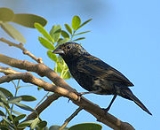
Blue-black Grassquit
Encyclopedia
The Blue-black Grassquit (Volatinia jacarina) is a small bird
in the tanager
family, Thraupidae. It was previously classified in the bunting
and American sparrow
family, Emberizidae
. It breeds from southern Mexico
through Central America
, and South America
as far as northern Chile
, Argentina
and Paraguay
, and on Trinidad and Tobago
. It is the only member of the genus Volatinia.
Adult Blue-black Grassquits are 10.2 cm (4 in) long and weigh 9.3 g (0.328047847577541 oz). They have a slender conical black bill. The male is glossy blue-black, with a black tail and wings; the white inner underwing is visible in flight or display. Female and immature birds have brown upperparts and dark-streaked buff underparts.
The male has a jumping display, often performed for long periods, which gives rise to the local name Johnny Jump-up. This is accompanied by a persistent wheezing jweeee call.
This is a common bird in semi-open areas, including cultivation and gardens. It makes a small cup nest, with a typical clutch of one to three pale green eggs blotched with reddish brown. Both sexes incubate for 9–10 days, with about the same period again for the young to fledge.
The Blue-black Grassquit feeds mainly on seeds. It is quite gregarious, and forms communal evening roosts.
Bird
Birds are feathered, winged, bipedal, endothermic , egg-laying, vertebrate animals. Around 10,000 living species and 188 families makes them the most speciose class of tetrapod vertebrates. They inhabit ecosystems across the globe, from the Arctic to the Antarctic. Extant birds range in size from...
in the tanager
Tanager
The tanagers comprise the bird family Thraupidae, in the order Passeriformes. The family has an American distribution.There were traditionally about 240 species of tanagers, but the taxonomic treatment of this family's members is currently in a state of flux...
family, Thraupidae. It was previously classified in the bunting
Bunting (bird)
Buntings are a group of Eurasian and African passerine birds of the family Emberizidae.They are seed-eating birds with stubby, conical bills, and are the Old World equivalents of the species known in North America as sparrows...
and American sparrow
American sparrow
American sparrows are a group of mainly New World passerine birds, forming part of the family Emberizidae. American sparrows are seed-eating birds with conical bills, brown or gray in color, and many species have distinctive head patterns....
family, Emberizidae
Emberizidae
The Emberizidae are a large family of passerine birds. They are seed-eating birds with a distinctively shaped bill.In Europe, most species are called buntings. In North America, most of the species in this family are known as sparrows, but these birds are not closely related to the sparrows, the...
. It breeds from southern Mexico
Mexico
The United Mexican States , commonly known as Mexico , is a federal constitutional republic in North America. It is bordered on the north by the United States; on the south and west by the Pacific Ocean; on the southeast by Guatemala, Belize, and the Caribbean Sea; and on the east by the Gulf of...
through Central America
Central America
Central America is the central geographic region of the Americas. It is the southernmost, isthmian portion of the North American continent, which connects with South America on the southeast. When considered part of the unified continental model, it is considered a subcontinent...
, and South America
South America
South America is a continent situated in the Western Hemisphere, mostly in the Southern Hemisphere, with a relatively small portion in the Northern Hemisphere. The continent is also considered a subcontinent of the Americas. It is bordered on the west by the Pacific Ocean and on the north and east...
as far as northern Chile
Chile
Chile ,officially the Republic of Chile , is a country in South America occupying a long, narrow coastal strip between the Andes mountains to the east and the Pacific Ocean to the west. It borders Peru to the north, Bolivia to the northeast, Argentina to the east, and the Drake Passage in the far...
, Argentina
Argentina
Argentina , officially the Argentine Republic , is the second largest country in South America by land area, after Brazil. It is constituted as a federation of 23 provinces and an autonomous city, Buenos Aires...
and Paraguay
Paraguay
Paraguay , officially the Republic of Paraguay , is a landlocked country in South America. It is bordered by Argentina to the south and southwest, Brazil to the east and northeast, and Bolivia to the northwest. Paraguay lies on both banks of the Paraguay River, which runs through the center of the...
, and on Trinidad and Tobago
Trinidad and Tobago
Trinidad and Tobago officially the Republic of Trinidad and Tobago is an archipelagic state in the southern Caribbean, lying just off the coast of northeastern Venezuela and south of Grenada in the Lesser Antilles...
. It is the only member of the genus Volatinia.
Adult Blue-black Grassquits are 10.2 cm (4 in) long and weigh 9.3 g (0.328047847577541 oz). They have a slender conical black bill. The male is glossy blue-black, with a black tail and wings; the white inner underwing is visible in flight or display. Female and immature birds have brown upperparts and dark-streaked buff underparts.
The male has a jumping display, often performed for long periods, which gives rise to the local name Johnny Jump-up. This is accompanied by a persistent wheezing jweeee call.
This is a common bird in semi-open areas, including cultivation and gardens. It makes a small cup nest, with a typical clutch of one to three pale green eggs blotched with reddish brown. Both sexes incubate for 9–10 days, with about the same period again for the young to fledge.
The Blue-black Grassquit feeds mainly on seeds. It is quite gregarious, and forms communal evening roosts.
External links
- Blue-black Grassquit videos, photos & sounds on the Internet Bird Collection

